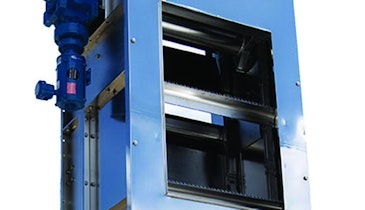Interested in Dewatering/Biosolids?
Get Dewatering/Biosolids articles, news and videos right in your inbox! Sign up now.
Dewatering/Biosolids + Get AlertsPersuading a community to accept Class A exceptional quality biosolids depends a lot on presentation and subliminal messaging. When the city of Sumner, Washington, decided to give away its Sumner Grow biosolids, wastewater superintendent Gregory Kongslie set out to make sure the product made a powerful first impression on residents.
“To be visually pleasing, biosolids must be free of debris,” says Kongslie. “It’s also important to keep dryer biosolids dry. Once rehydrated, they release odors.” The plant uses two 1/4-inch perforated plate fine screens (Kusters Zima) at the headworks, and a SludgeMASTER Model RK72 continuous-mix dryer (RDP-Fenton Technologies), producing 400 dry tons of biosolids annually.
To store the granules, the city built a 2,700-square-foot open-sided concrete building similar to a carport, but with elevated walls and an extended overhang.
“Protecting our biosolids from the elements and in a permanent building sent a message that here is something of value,” says Kongslie.
At 15 to 20 percent fines, the granules resemble soil and are somewhat dusty. “We left the top quarter of the building open to help control dust,” says Kongslie. “By maintaining a bright, safe, pleasant environment, the building invites people to walk in.”
The plant has a John Deere skid-steer loader and compact tractor to load biosolids into homeowners’ pickup trucks or transport granules to the 10-cubic-yard distribution kiosk, a sturdy wooden structure with an overhanging cedar shingle roof that imparts a homey feeling. Two shovels stand nearby for residents who forget theirs.
“We lose several shovels each year when people inadvertently walk away with them,” says Kongslie. “However, our security camera once caught a man who drove up, jumped out of his vehicle, grabbed a shovel, and left. We read his license plate number, the police gave us his contact information, and we had our shovel back after one phone call.”
Besides the facility enhancing the image of quality, the Sumner Grow brochure at the kiosk (and online) confirms it with scientific information. Updated annually, it shows the previous year’s analysis of Sumner Grow quality assurance testing.
“Our product far exceeds the EPA pathogen and vector attraction requirements and the heavy metal standards for Class A exceptional quality biosolids,” says Kongslie. “For example, the standards require no more than 300 ppm lead and 420 ppm nickel. In 2015, Sumner Grow averaged 11 ppm of lead and nickel.”
Kongslie’s effort to elevate Sumner Grow to the most desirable product among its peers has worked. By mid-April, all the biosolids made over winter are gone, and residents are waiting for more.





